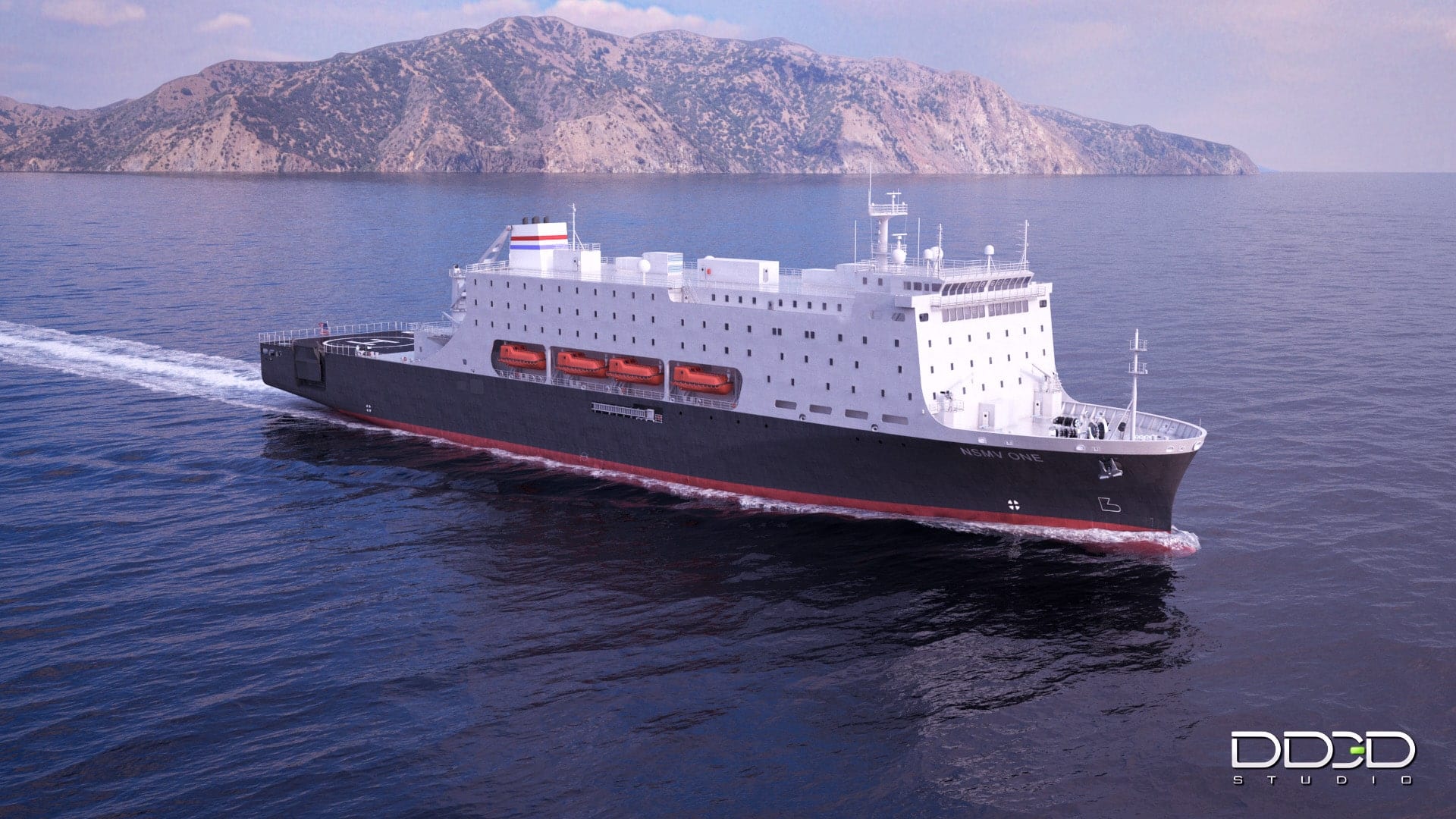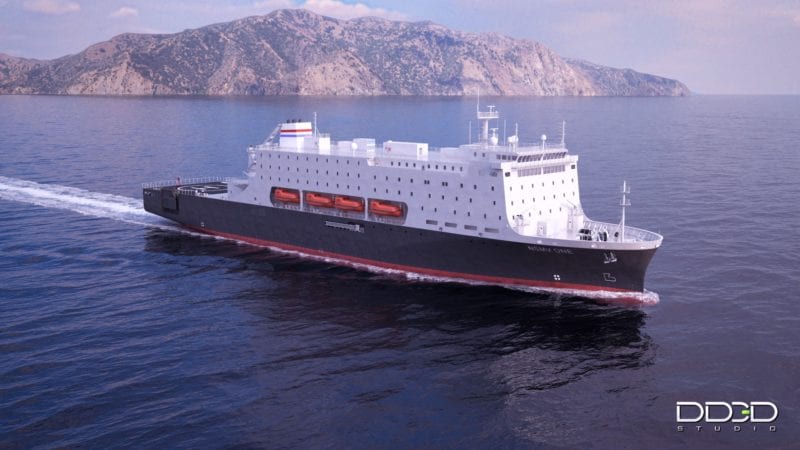Trump’s Return to OPEC Politics Muddies Oil Talks Next Month
US President Donald Trump has raised the stakes for a meeting of an OPEC+ ministerial panel next month, with his call for the group to lower oil prices.




By Salvatore R. Mercogliano, Ph.D. – National Maritime Day (May 22) came a month earlier than usual with the announcement by the Maritime Administration and TOTE Services, LLC, that Philly Shipyard, Inc., had been selected to build the first of a new class of training ships for the state maritime academies. Known as the National Security Multi-Mission Vessel (NSMV), they will replace the aging school ships of the State University of New York Maritime College, Massachusetts Maritime, Maine Maritime, California State University Maritime Academy, and Texas A&M Maritime Academy. The ships will be able to support 600 cadets with instructional spaces, a training bridge, and serve in national disasters with the ability to berth up to 1,000 personnel. The first ship is earmarked to replace New York’s 58-year old Empire State VI.
The construction of a training vessel for the nation’s oldest maritime academy, at one of America’s longest operational shipyards, with the secondary role of assistance during time of emergencies could not have been more well timed. With the hospital ships USNS Mercy in Los Angeles and USNS Comfort in New York City, converted T-8 supertankers crewed by civilian merchant mariners of the Military Sealift Command and providing aid during the COVID-19 pandemic, ships like the future Empire State VII would be ideal assets for the nation. The historic relationship between the merchant marine and the Philly Shipyard demonstrates the role that American sea power has played in the past.
In 1775, George Washington, commanding Continental forces besieging Boston, informed Congress of his actions to outfit a squadron of privateers to harass British maritime supply lines and efforts along the New England coast. He recommended the outfitting of a Continental Navy to complement the Army he commanded. On October 13, the Congress authorized the purchase of merchant ships along the Philadelphia waterfront to become the first ships in the new Navy. The merchant vessel Alfred became the initial warship in this new Navy and her first lieutenant was an experienced merchant mariner who had assumed a new last name to avoid murder charges in the Caribbean, John Paul Jones.
Philadelphia has always been a center of American maritime history. In 1794, when the nation once again needed a Navy to protect its commerce from Barbary pirates, it was Philadelphia’s own Joshua Humphreys who built one of the first six frigates for the new United States Navy, aptly named United States. Later, Philadelphia became home to one of the first Navy yards in the nation – the others being in Portsmouth, NH; Charlestown, MA; Brooklyn, NY; Washington DC; and Gosport, VA.
What we know today as the Philly Shipyard built its first ship for the Navy in 1841, USS Mississippi. After the Civil War, the yard stopped production, but along the Delaware River, commercial shipyards littered the bank and became the maritime focus for the nation. At nearly that same time, in New York City, the local Chamber of Commerce and other interested parties lobbied the state government in Albany to fund a maritime school to train future merchant marine officers and instill a degree of professionalism in the industry. The state funded the endeavor and under the direction of naval officer Stephen B. Luce, who later founded the Naval War College, Congress authorized the Navy to assign a training ship and officers to assist in the education of cadets.
On December 14, 1874, the sloop-of-war St. Mary’s arrived in New York harbor and the New York Nautical School came into existence. St. Mary’s was the first of eight training ships used by New York Maritime. In 1907, the gunboat Newport introduced steam-propulsion to the curriculum. The school continued to grow when the former Hog Island freighter – built on the site of the modern Philadelphia International Airport – Procyon was transferred to the school and renamed Empire State. In 1938, the cadets of the renamed New York Merchant Marine Academy moved off their ship into permanent facilities ashore on Throggs Neck at the refurbished Fort Schuyler.
The school remained the oldest state maritime training academy. Other state schools joined it along with the United States Merchant Marine Academy directly across the bay in Queens. Other ships replaced the original Empire State. A former attack transport, USS Hydrus became Empire State II, the namesake of the current Mercy was Empire State III. The Military Sea Transportation Service, the forerunner of the Military Sealift Command (MSC) provided USNS Henry Gibbons, Empire State IV along with USNS Barrett, Empire State V. In 1990, the current Empire State VI, the ex-Mormactide, built in 1962, arrived and continues to serve as the oldest of the nation’s training ships.
During World War Two, New York Maritime, and the other maritime academies, provided officers for the American merchant marine. The US merchant marine was the only civilian organization on the front lines of the war with 733 ships sunk and nearly 10,000 mariners killed. As merchant ships were being sunk just off the coast of New York and the Delaware River, the most powerful warships the world has ever imagined came off the ways at the Philadelphia Naval Shipyard, today’s Philly Shipyard.
Out from Philadelphia steamed the battleship Washington in 1941. She would engage and sink the Japanese battleship Kirishima in a dramatic night brawl off Guadalcanal the following year. She would be followed by New Jersey and Wisconsin, the former the flagship of Admiral William F. “Bull” Halsey during the Battle of Leyte Gulf. The latter served the Navy until the Persian Gulf War when during a bombardment mission off Kuwait she was targeted by Iraqi surface-to-surface missiles. Yet Philadelphia was the site for ships even more powerful, as two massive drydocks were constructed.
Unlike previous ships, that were built on launch ways and slid in the water, this new class of ships would be too large. Known as the Montana-class battleship, the lead ship, along with the second one, Ohio, were to be built in these new drydocks in Philadelphia. The ships would feature twelve 16-inch guns, three more than the New Jersey and Wisconsin. They were designed to tangle with the biggest ships in the Axis navies, such as Yamato and Tirpitz. By 1943, that threat had subsided, and the pressing need was not for massive battlewagons, but landings ships and escort vessels, so Philly shifted over to building them. One of those ships, LST 325 is now a museum ship in Evansville, Indiana, a testimony to American maritime construction.
After World War Two, the Philadelphia Navy Yard was used to store surplus warships in a reserve status, known as mothballs. Today, that reserve fleet still exists as the Naval Inactive Ship Maintenance Facility with frigates, destroyers, amphibious vessels, the Marine Corps’ aviation logistics support ship SS Wright, and even the carrier ex-John F. Kennedy. The naval shipyard built its last ship in 1970. USS Blue Ridge (LCC-19) remains operational today as the flagship for the U.S. Navy 7th Fleet stationed in the western Pacific. In 1996, with the drawdown from the Cold War and as part of the Base Realignment and Closure (BRAC) process, the Philadelphia Naval Shipyard was closed.
In 1998, drydocks 4 and 5 – the large ones designed for Montana and Ohio – were broken off from the property and bought by Kvaerner, a Norwegian shipbuilding firm to construct four containerships for Matson Lines. In the early 2000s, the yard changed hands and became the Aker Philadelphia Shipyard. Since 2007, with the launch of Overseas Houston, the yard built 24 tankers that form the basis for most of the tankers in the American Jones Act-fleet. In 2018 and 2019, the renamed Philly Shipyard delivered its most recent vessels, MV Daniel K. Inouye and Kaimana Hila for Matson Lines.
The award of the NSMV to Philly Shipyard, with the potential to build at least five ships provides needed work for the American domestic maritime industry. With 90 percent of the world’s ships constructed in yards in the People’s Republic of China, the Republic of Korea, and Japan, the United States finds its playing on an uneven field where foreign shipyards are being consolidated and realigned to outperform each other with massive government support. The NSMV will train thousands of future merchant mariners well into the 21st century. Variations and the template of the ships could be used by the Navy for replacements for the hospital ship Comfort and Mercy; or as command ships like Blue Ridge, as tenders for the US Navy submarines and destroyers, or replace the aviation logistic support ship Wright.
No one could mistake USS Montana for the future Empire State VII. Yet the lineage of the former Philadelphia Navy Yard and that of the American merchant marine is intertwined throughout the history of this nation. Today, the United States possesses the most powerful Navy in the world, and it is being challenged by a new rival on the high seas, that of China. The once numerous US merchant marine has declined from its position of dominance at the end of the Second World War to its current place as 22nd in the world, while China is second.
Not far from the projected Montana’s launch site, where the NSMV will be built, sits the flagship of the American merchant marine. The last passenger ship to hold the Blue Riband for the fastest crossing of the Atlantic, the SS United States resides at Pier 82 in Philadelphia, just a few miles from the Philly Shipyard. The ship was the epitome of American commercial shipbuilding and the merchant marine, but now lays dormant and rusts away, awaiting an uncertain future.
It is perhaps fate that a new class of ships, that may represent a revitalization of the American merchant marine and maritime industry will be built in its shadow. A drydock that was meant to project the hard application of sea power will construct a ship that represents the soft application by training and educating future mariners. In much the same way that Alfred was taken over by the Navy as its initial warship in Philadelphia, the drydocks for the Montana’s have served the opposite purpose. Constructed for war, since 1996 they have built thirty ships for the American merchant marine and will continue to do so in the future with the National Security Multi-Mission Vessels.
Salvatore R. Mercogliano is an associate professor of History at Campbell University in Buies Creek, North Carolina and teaches courses in World Maritime History and Maritime Security.
Join the gCaptain Club for curated content, insider opinions, and vibrant community discussions.


Join the 108,866 members that receive our newsletter.
Have a news tip? Let us know.







Maritime and offshore news trusted by our 108,866 members delivered daily straight to your inbox.



Essential news coupled with the finest maritime content sourced from across the globe.
Sign Up